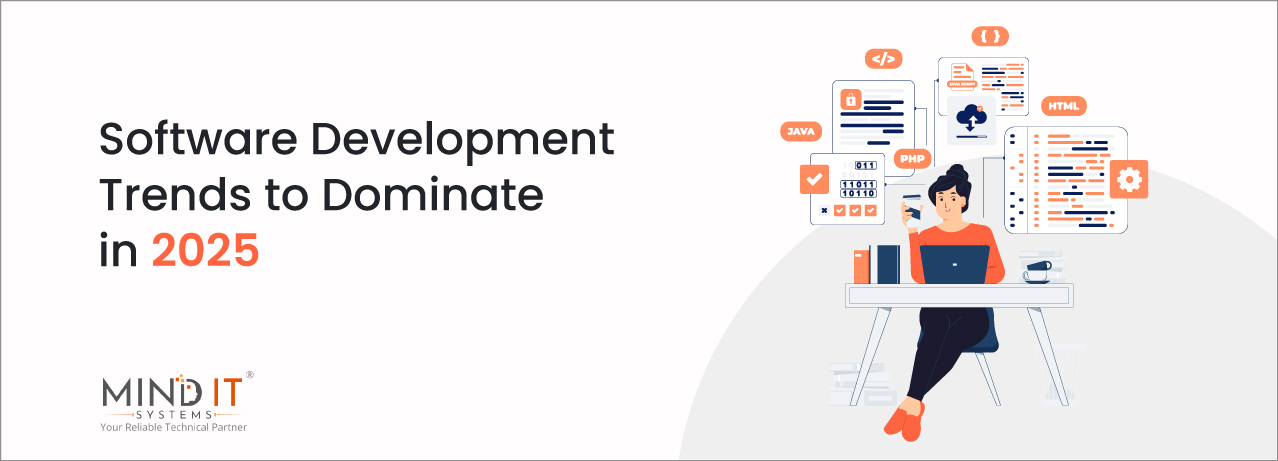
Software Development Trends to Dominate in 2025
Introduction
The software development industry is at the cusp of a groundbreaking transformation. As digital innovation accelerates globally, 2025 promises to bring forth trends redefining how businesses operate, connect, and deliver value. Companies that adapt to these changes early will find themselves at the forefront of the next wave of technological evolution.
To uncover the most impactful industry trends, let’s explore the insights and innovations set to dominate software development in 2025.
Join us to discover.
Table of Contents
Key Insights for 2025
- Projected Revenue: The global application development software market is set to generate $195.80 billion in revenue.
- Annual Growth: A consistent growth rate of 6.30% is forecasted from 2025 to 2029.
- Market Leadership: Enterprise software is expected to lead the market by 2025 with a projected volume of US$315.00bn, driven by increasing demand for scalable solutions.
- Emerging Technologies: Focus on AI, sustainability, and low-code/no-code platforms are driving innovation.
These perceptions paint a promising picture for the future of software development, but amidst these chances, organizations must also recognize and address six critical issues that impact software development projects. From balancing security concerns to handling technical debt and aligning team capabilities with ever-evolving technologies, these challenges must be tackled for successful project delivery and long-term success.
Top Software Development Trends to Watch in 2025
1. Artificial Intelligence and Machine Learning
AI and ML continue to dominate the software development space. In 2025, we expect these technologies to seamlessly integrate into development processes, enabling smarter applications with predictive analytics, personalized user experiences, and robust automation capabilities. Generative AI, specifically, will redefine content creation and application prototyping.
Key Applications:
- Predictive maintenance in industries
- Personalized marketing automation
- Advanced chatbots and virtual assistants
AI-driven technologies will reshape industries by optimizing processes, unlocking new capabilities, and enabling data-driven decision-making. As adoption grows, organizations will gain an unprecedented edge in efficiency, innovation, and customer satisfaction.
2. Low-Code and No-Code Development Platforms
With businesses seeking rapid deployment solutions, low-code, and no-code platforms will further gain traction. These platforms empower non-technical users to build and deploy applications, significantly reducing time-to-market and development costs.
Benefits:
- Democratization of development
- Faster prototyping and iterative processes
- Enhanced collaboration between IT and business teams
These platforms enable a shift towards inclusive innovation, where teams across disciplines can co-create solutions. By lowering technical barriers, businesses can respond to challenges faster and foster a culture of agility and creativity.
3. Cloud-Native Development
Cloud-native applications are designed to leverage the full potential of cloud platforms, offering scalability, resilience, and speed. Kubernetes and microservices architectures are expected to remain central to this trend, helping businesses adopt DevOps practices efficiently.
Trends within Cloud Computing:
- Serverless computing adoption
- Multi-cloud and hybrid cloud strategies
- Enhanced focus on cloud security
As digital ecosystems grow, cloud-native approaches will be essential for businesses to adapt to dynamic demands. Organizations can deliver consistent performance, accelerate innovation, and drive sustained growth by optimizing for the cloud.
4. Edge Computing
Edge computing will play a crucial role in reducing latency and improving real-time data processing. With the proliferation of IoT devices, edge computing enables computing closer to the data source, ensuring faster response times and enhanced user experiences.
Use Cases:
- Autonomous vehicles
- Smart city infrastructures
- Real-time analytics in healthcare
Edge computing represents a paradigm shift in processing, bringing intelligence closer to the data source. This capability will unlock new possibilities for industries that rely on low-latency responses and real-time analytics to meet user expectations.
5. Sustainability in Software Development
Sustainable practices are becoming integral to the software development lifecycle. From energy-efficient coding practices to utilizing green data centers, developers are prioritizing eco-friendly solutions to minimize environmental impact.
Sustainable Practices:
- Optimizing software for reduced energy consumption.
- Transitioning to renewable energy-powered data centers.
- Promoting circular economy principles in hardware usage.
Adopting sustainable practices is no longer a trend but a necessity. Developers have a unique opportunity to create software solutions that drive progress and contribute to a healthier planet, building a legacy of responsible innovation.
6. Cybersecurity-First Development
With increasing threats, a cybersecurity-first approach is no longer optional. Cybersecurity in software development is more crucial than ever as cyberattacks become more sophisticated. In 2025, developers will integrate security measures directly into the development pipeline, adopting practices such as DevSecOps and zero-trust architectures.
Enhanced Security Measures:
- AI-driven threat detection
- Automated vulnerability scanning
- Incorporating security into CI/CD pipelines
Organizations must proactively adopt cybersecurity-first practices to defend against evolving threats. By embedding security into every stage of the development process, they can build resilient systems that safeguard their data, reputation, and operations.
7. Progressive Web Apps (PWAs)
PWAs are poised to blur the lines between web and mobile applications. They offer fast, reliable, and engaging experiences across devices, making them a preferred choice for businesses aiming to deliver seamless user experiences without the complexities of native app development.
Advantages:
- Offline functionality
- Cross-platform compatibility
- Cost-effective development
PWAs offer a transformative solution for businesses aiming to deliver high-quality, device-agnostic experiences. As more companies adopt this approach, users can expect greater convenience, accessibility, and functionality across all their favorite platforms.
Market Dynamics: What’s Driving Change?
The post-2020 digital transformation is driving rapid shifts in the software development landscape, with key forces such as personalized experiences, operational efficiency, and sustainability leading the way. A flexible software development life cycle (SDLC) is essential for businesses to stay competitive. Adopting an agile SDLC approach will allow companies to keep pace with these changes, accelerating innovation while ensuring high-quality, secure software.
As companies adopt these transformative trends, choosing the right outsourcing partner for software development needs becomes a strategic advantage. The right partner can help businesses scale efficiently, minimize risks, and stay at the forefront of technological advancements.
Let’s explore the forces shaping these trends and their broader implications for businesses and developers alike.
AI’s Expanding Role
Artificial Intelligence is advancing applications and enhancing the development process itself. Tools powered by AI assist developers by generating code snippets, optimizing performance, and predicting potential bugs before deployment.
Global Shift to Green Technology
Governments and enterprises worldwide are aligning with sustainability goals. This shift has encouraged the adoption of green technologies, making energy-efficient software development practices an industry standard.
This dynamic environment underscores the need for businesses to stay agile and ready for the future.
Future Outlook: Preparing for 2025
To thrive in 2025, organizations must approach these trends strategically. Upskilling teams, adopting AI-driven tools, and integrating agile practices will be key to staying competitive. Businesses should also prioritize secure and sustainable development to meet evolving standards.
Take a moment to assess how much technical debt your business is taking on. Resolving this issue will pave the way for smoother growth, faster innovation, and sustained success in the digital era.
By staying ahead of industry changes, companies can turn challenges into opportunities and lead in this transformative time.
Share this post
About the Author

Sujoy Roy
(Head – Digital Marketing)
From my teenage time, I had a quench to solve problems and loved leadership. Starting my career in relation management, ignited my passion for managing people. While managing I realized technology needs to be incorporated to keep pace with the changing world & do my work efficiently.

